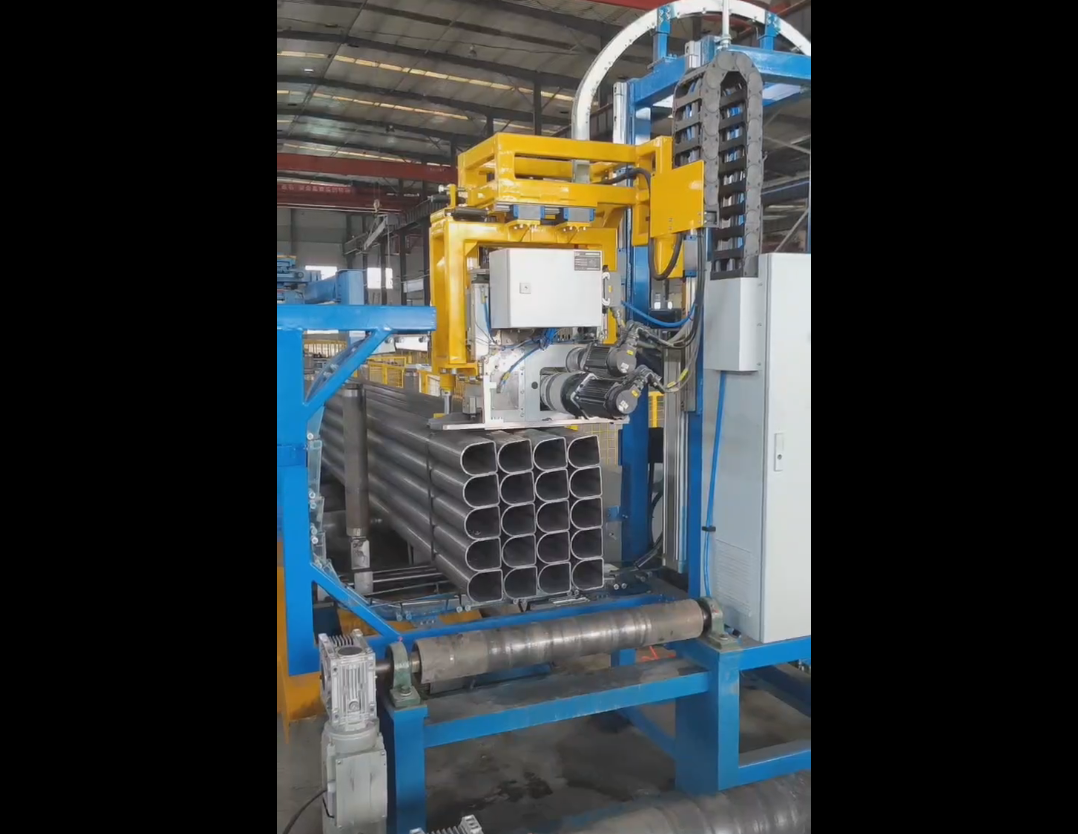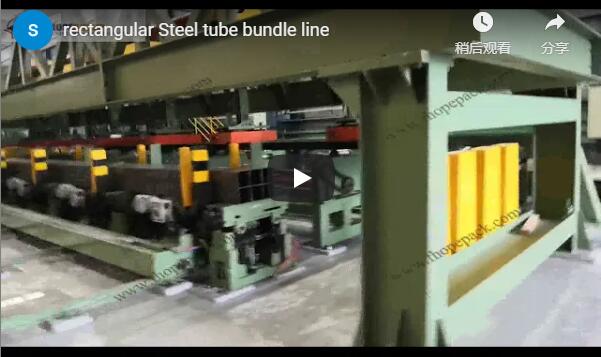Handling and packaging long products like rectangular steel tubes efficiently and safely is a critical bottleneck in many fabrication shops and steel service centers. Manual bundling is labor-intensive, time-consuming, and can lead to inconsistent package quality and potential safety hazards. This automated rectangular steel tube bundling and strapping line demonstrates a modern solution designed to streamline this process, enhancing throughput and consistency using robust steel strip strapping.
1. System Overview: Automating Rectangular Tube Handling
This fully automatic system is engineered to receive loose rectangular steel tubes, arrange them into predetermined bundle configurations, and securely strap them using durable steel strips. The entire process, from tube infeed to strapped bundle outfeed, operates with minimal human intervention, significantly boosting operational efficiency and reducing manual handling requirements common in traditional metal fabrication environments.

2. Key Components and Functionality Breakdown
Understanding the machine requires looking at its core components and how they interact:
- Infeed System: Typically consists of conveyors or loading tables designed to receive tubes from upstream processes (like cutting or forming lines) and transfer them into the bundling system. Proper alignment starts here.
- Tube Alignment & Arrangement: Mechanisms (e.g., pushers, guides, vibration tables) precisely align the tubes side-by-side and layer-by-layer to form the desired bundle shape and count. This ensures tight, stable bundles.
- Bundling Formation Station: Where the arranged tubes are gathered and held securely in the final bundle configuration, ready for strapping. This might involve clamps or side supports.
- Automatic Steel Strapping Heads: The heart of the securing process. These heads automatically feed, tension, seal (usually via notch or seal-less joint), and cut the steel strapping around the bundle at pre-set locations. Multiple heads are often used for longer bundles or increased stability.
- Outfeed Conveyor System: Transports the completed, strapped bundles away from the machine, often integrating with warehouse storage systems, weighing stations, or loading areas.
- Control System (PLC): A Programmable Logic Controller orchestrates the entire sequence, managing sensors, actuators, strapping parameters, and safety interlocks. HMIs (Human-Machine Interfaces) allow operators to select recipes, monitor status, and troubleshoot.
3. Technical Specifications & Data Insights
While specific machine capabilities vary, typical parameters for such lines highlight their performance potential:
| Parameter | Typical Range / Specification | Benefit / Implication |
|---|---|---|
| Tube Size Range | 20x20mm to 150x150mm (or larger, custom) | Versatility to handle common structural and mechanical tubing. |
| Tube Length | 3m to 12m (or specified) | Accommodates standard mill lengths and cut-to-size pieces. |
| Bundle Size (WxH) | 300x300mm to 1000x1000mm (configurable) | Flexibility in package size based on customer or shipping needs. |
| Strapping Material | Steel Strip (e.g., 16mm, 19mm, 32mm width) | High tensile strength for secure bundling of heavy products. |
| Number of Straps | 2 to 6 (programmable based on bundle length) | Ensures bundle integrity along its entire length. |
| Strapping Cycle Time | 30-60 seconds per bundle (approx.) | Indicates potential throughput and operational speed. |
| Strapping Head Type | Electric or Pneumatic/Hydraulic | Influences speed, tension control, and maintenance needs. |
| Control System | PLC (e.g., Siemens, Allen-Bradley) with HMI | Provides reliable automation, recipe management, diagnostics. |
| Power Requirements | 480V/3Ph/60Hz (or local standard) | Standard industrial power compatibility. |
| Approx. Footprint | Varies significantly based on configuration | Requires dedicated floor space planning. |
Note: These are representative figures. Actual specifications depend on the specific model and manufacturer.
4. Design Considerations for Optimal Performance
Several design factors are crucial for the reliability and effectiveness of these systems:
- Robust Construction: Built with heavy-gauge steel frames and durable components to withstand the demanding industrial environment and the weight of steel tubes.
- Flexibility and Adjustability: Quick changeover capabilities to handle different tube dimensions and bundle configurations are essential for job shops or high-mix environments.
- Strapping Head Reliability: The strapping heads are critical wear components. Designs emphasizing durability, ease of maintenance, and consistent tensioning/sealing are paramount.
- Safety Features: Comprehensive guarding, light curtains, emergency stops, and interlocks are non-negotiable to protect operators.
- Smooth Material Handling: Conveyor design and transfer points must prevent tube damage (scratches, dents) and ensure uninterrupted flow.
- Integration: Ability to seamlessly integrate with upstream cutting/forming lines and downstream warehouse management systems (WMS) via communication protocols.
5. Operational Advantages and ROI in Fabrication
Implementing an automated tube bundling line offers significant advantages:
- Increased Throughput: Dramatically faster than manual bundling, increasing overall production capacity.
- Reduced Labor Costs: Frees up personnel previously assigned to manual bundling for higher-value tasks.
- Improved Bundle Quality: Consistent strap tension and placement lead to uniform, stable, and professional-looking bundles, reducing transit damage.
- Enhanced Workplace Safety: Minimizes risks associated with manual lifting, handling sharp edges, and repetitive motions.
- Optimized Material Flow: Creates a smoother, more predictable flow from production to shipping or storage.
- Accurate Package Counts: Automation reduces errors in bundle piece counts.
The Return on Investment (ROI) is typically realized through labor savings, increased output, reduced product damage, and improved safety records.
6. User Experience & Practical Application Insights
From an operational standpoint, users often highlight:
- Ease of Operation (Post-Setup): Modern PLC controls with intuitive HMIs simplify recipe selection and system monitoring.
- Importance of Maintenance: Regular preventative maintenance, especially on strapping heads and conveyors, is vital for consistent uptime. Coil changes for steel strapping also need to be efficient.
- Impact on Logistics: Well-formed, securely strapped bundles are easier and safer to handle with forklifts, stack in warehouses, and load onto trucks.
- Material Finish Considerations: For sensitive surfaces (e.g., coated or polished tubes), protective measures like non-metallic strapping or specialized conveyor surfaces might be necessary alternatives or additions. This specific line uses steel strip, ideal for raw or structural steel tubes where high strength is the priority.
7. Conclusion: Investing in Efficiency and Safety
Automated rectangular steel tube bundling and strapping lines, particularly those utilizing robust steel strapping, represent a significant technological step forward for steel processors and fabricators. As demonstrated in the video, these systems tackle a physically demanding and often inefficient process, transforming it into a streamlined, automated workflow. By investing in such technology, companies can achieve substantial gains in productivity, package quality, and worker safety, ultimately strengthening their competitive position in the market. Evaluating the technical specifications, design features, and operational benefits is key to selecting a system that aligns with specific production needs.
For further information on steel standards and industry practices, resources like the American Iron and Steel Institute (AISI) or ASTM International can provide valuable context.


